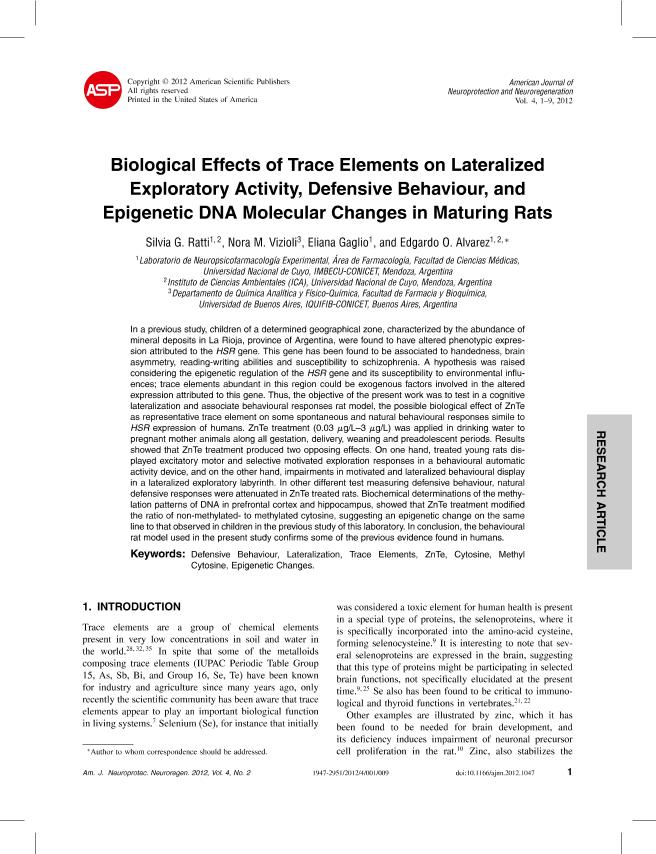Artículo
Biological Effects of Trace Elements on Lateralized Exploratory Activity, Defensive Behaviour, and Epigenetic DNA Molecular Changes in Maturing Rats
Fecha de publicación:
12/2012
Editorial:
American Scientific Publishers
Revista:
American Journal of Neuroprotection and Neuroregeneration
ISSN:
1947-2951
Idioma:
Inglés
Tipo de recurso:
Artículo publicado
Clasificación temática:
Resumen
In a previous study, children of a determined geographical zone, characterized by the abundance of mineral deposits in La Rioja, province of Argentina, were found to have altered phenotypic expression attributed to the HSR gene. This gene has been found to be associated to handedness, brain asymmetry, reading-writing abilities and susceptibility to schizophrenia. A hypothesis was raised considering the epigenetic regulation of the HSR gene and its susceptibility to environmental influences; trace elements abundant in this region could be exogenous factors involved in the altered expression attributed to this gene. Thus, the objective of the present work was to test in a cognitive lateralization and associate behavioural responses rat model, the possible biological effect of ZnTe as representative trace element on some spontaneous and natural behavioural responses simile to HSR expression of humans. ZnTe treatment (0.03 µg/L - 3 µg/L) was applied in drinking water to pregnant mother animals along all gestation, delivery, weaning and preadolescent periods. Results showed that ZnTe treatment produced two opposing effects. On one hand, treated young rats displayed excitatory motor and selective motivated exploration responses in a behavioural automatic activity device, and on the other hand, impairments in motivated and lateralized behavioural display in a lateralized exploratory labyrinth. In other different test measuring defensive behaviour, natural defensive responses were attenuated in ZnTe treated rats. Biochemical determinations of the methylation patterns of DNA in prefrontal cortex and hippocampus, showed that ZnTe treatment modified the ratio of non-methylated- to methylated cytosine, suggesting an epigenetic change on the same line to that observed in children in the previous study of this laboratory. In conclusion, the behavioural rat model used in the present study confirms some of the previous evidence found in humans.
Palabras clave:
Defensive Behaviour
,
Trace Elements
,
Methyl Cytosine
,
Epigenetic Changes
Archivos asociados
Licencia
Identificadores
Colecciones
Articulos(IMBECU)
Articulos de INST. DE MEDICINA Y BIO. EXP. DE CUYO
Articulos de INST. DE MEDICINA Y BIO. EXP. DE CUYO
Articulos(IQUIFIB)
Articulos de INST.DE QUIMICA Y FISICO-QUIMICA BIOLOGICAS "PROF. ALEJANDRO C. PALADINI"
Articulos de INST.DE QUIMICA Y FISICO-QUIMICA BIOLOGICAS "PROF. ALEJANDRO C. PALADINI"
Citación
Ratti, Silvia Gabriela; Vizioli, Nora Matilde; Gaglio, Eliana; Alvarez Toro, Edgardo Orozimbo; Biological Effects of Trace Elements on Lateralized Exploratory Activity, Defensive Behaviour, and Epigenetic DNA Molecular Changes in Maturing Rats; American Scientific Publishers; American Journal of Neuroprotection and Neuroregeneration; 4; 2; 12-2012; 167-175
Compartir
Altmétricas




